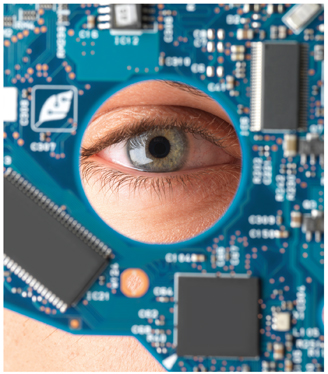 Originally used in the aircraft industry, event data recorders (EDRs), commonly known as "black boxes," are now incorporated in a variety of consumer products, ranging from household appliances and alarm panel systems to cars and copiers. Recording a final data picture just before a product fails, EDRs are tamper-proof with a read/write memory device that unobtrusively captures a variety and wealth of product information that may be useful to an adjuster evaluating subrogation arising from a loss. For example, in appliances, EDRs can be triggered by a power surge or temperature spike, either of which can support an insured's claim that he or she saw the product begin to smoke, catch on fire, or fail to operate properly.
Originally used in the aircraft industry, event data recorders (EDRs), commonly known as "black boxes," are now incorporated in a variety of consumer products, ranging from household appliances and alarm panel systems to cars and copiers. Recording a final data picture just before a product fails, EDRs are tamper-proof with a read/write memory device that unobtrusively captures a variety and wealth of product information that may be useful to an adjuster evaluating subrogation arising from a loss. For example, in appliances, EDRs can be triggered by a power surge or temperature spike, either of which can support an insured's claim that he or she saw the product begin to smoke, catch on fire, or fail to operate properly.
It is easy to compare EDRs to a constant surveillance system that monitors its surroundings, similar to the telescreen in George Orwell's classic novel "1984," which monitored citizens at all times. However, unlike the telescreen and the negative "Big Brother is Watching" connotation, EDRs are positive mechanisms when used appropriately and consistently with state legislative requirements.
The Age of Smart Technology
EDRs and smart technology programs have greatly expanded available data about products and their environments. Some manufacturers provide EDRs that monitor and diagnose appliances off-site, but data collected varies. For example, some EDRs provide operating hours, switch status and attempts to connect outside agencies, such as a fire panel, and so on. These days, smart technology is being used to control appliances, as well as heating and air conditioning systems to save energy and increase safety through the use of meters and controls that take specific measurements at pre-determined intervals. Such controls and metering can acquire, analyze and convert energy data to improve efficiency.
Recommended For You
Want to continue reading?
Become a Free PropertyCasualty360 Digital Reader
Your access to unlimited PropertyCasualty360 content isn’t changing.
Once you are an ALM digital member, you’ll receive:
- Breaking insurance news and analysis, on-site and via our newsletters and custom alerts
- Weekly Insurance Speak podcast featuring exclusive interviews with industry leaders
- Educational webcasts, white papers, and ebooks from industry thought leaders
- Critical converage of the employee benefits and financial advisory markets on our other ALM sites, BenefitsPRO and ThinkAdvisor
Already have an account? Sign In Now
© 2025 ALM Global, LLC, All Rights Reserved. Request academic re-use from www.copyright.com. All other uses, submit a request to [email protected]. For more information visit Asset & Logo Licensing.








